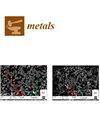Active and Passive Filling Stir Repairing of AISI 304 Alloy
IF 2.5
3区 材料科学
Q3 MATERIALS SCIENCE, MULTIDISCIPLINARY
引用次数: 0
Abstract
This study investigates active filling friction stir repair (AF-FSR) and passive filling friction stir repair (PF-FSR) for repairing AISI 304 stainless steel sheets, focusing on addressing the challenges posed by high melting point metals. The research involved repairing overlapping 2 mm thick sheets with pre-drilled holes of 2, 4, and 6 mm diameters, simulating broken components. Various process parameters, including rotational speed, dwell time, and the use of metal fillers, were tested to evaluate their impact on repair quality. The results demonstrated that PF-FSR provided superior mechanical strength to AF-FSR, particularly for larger pre-hole diameters. PF-FSR achieved higher shear tension strength due to better defect filling and reduced void formation, with shear tension strengths exceeding 25 kN for larger pre-holes and lower variability in strength measurements. AF-FSR was less effective for larger pre-holes, resulting in significant voids and reduced strength. Microstructural analysis revealed that PF-FSR facilitated more efficient material mixing and filling, minimizing unrepaired regions. However, excessive rotational speeds and dwell times in PF-FSR led to deformation and flash formation, highlighting the need for optimal parameter selection. Although further studies are needed, this study confirms the feasibility of FSR techniques for repairing small defects in AISI 304 steels, offering valuable insights for sustainable manufacturing practices in industries such as automotive and aerospace, where efficient and reliable repair methods are critical.主动和被动填充搅拌修复 AISI 304 合金
本研究调查了用于修复 AISI 304 不锈钢板的主动填充搅拌摩擦修复 (AF-FSR) 和被动填充搅拌摩擦修复 (PF-FSR),重点是解决高熔点金属带来的挑战。研究内容包括修复重叠的 2 毫米厚的板材,板材上有直径为 2、4 和 6 毫米的预钻孔,模拟破损的部件。测试了各种工艺参数,包括旋转速度、停留时间和金属填料的使用,以评估它们对修复质量的影响。结果表明,PF-FSR 的机械强度优于 AF-FSR,尤其是在孔前直径较大的情况下。PF-FSR 的剪切拉伸强度更高,这得益于更好的缺陷填充和更少的空隙形成,对于较大的预孔,剪切拉伸强度超过 25 kN,而且强度测量的变异性更低。AF-FSR 对较大预孔的效果较差,导致空洞明显,强度降低。微观结构分析表明,PF-FSR 能更有效地混合和填充材料,最大限度地减少未修复区域。然而,PF-FSR 中过高的旋转速度和停留时间会导致变形和飞边的形成,这就突出了优化参数选择的必要性。虽然还需要进一步研究,但本研究证实了 FSR 技术在修复 AISI 304 钢中小缺陷方面的可行性,为汽车和航空航天等行业的可持续生产实践提供了宝贵的见解,在这些行业中,高效可靠的修复方法至关重要。
本文章由计算机程序翻译,如有差异,请以英文原文为准。
求助全文
约1分钟内获得全文
求助全文
来源期刊

Metals
MATERIALS SCIENCE, MULTIDISCIPLINARY-METALLURGY & METALLURGICAL ENGINEERING
CiteScore
4.90
自引率
13.80%
发文量
1832
审稿时长
1.5 months
期刊介绍:
Metals (ISSN 2075-4701) is an open access journal of related scientific research and technology development. It publishes reviews, regular research papers (articles) and short communications. Our aim is to encourage scientists to publish their experimental and theoretical results in as much detail as possible. Therefore, there is no restriction on the length of the papers. The full experimental details must be provided so that the results can be reproduced. Metals provides a forum for publishing papers which advance the in-depth understanding of the relationship between the structure, the properties or the functions of all kinds of metals.
 求助内容:
求助内容: 应助结果提醒方式:
应助结果提醒方式:


